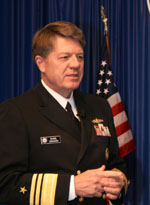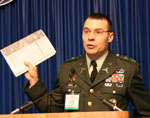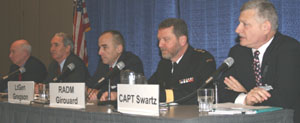Friday, February 2, 2007
SIGNAL's Online Show Daily
West 2007
Day 3
Quote of the Day:
“The second mouse gets the cheese. We want to be the second mouse and feed off of industry.”
—Vice Adm. Mark J. Edwards, USN, deputy chief of naval operations for communications networks (N-6).
 |
| Vice Adm. Mark J. Edwards, USN, deputy chief of naval operations for communications networks (N-6), gives the Friday luncheon keynote address. |
The conference videophile was the day’s keynote speaker, Vice Adm. Mark J. Edwards, USN, deputy chief of naval operations for communications networks (N-6). Adm. Edwards took a broad view of the information technology revolution and described numerous opportunities to implement sweeping new capabilities throughout the Navy. Instead of merely building on existing technologies, the U.S. Navy would explore wholly new applications, Adm. Edwards indicated.
The admiral demonstrated just how new information technology capabilities could be exploited more effectively. He showed a display of a standard Navy online video that looked proper, well-designed and unremarkable. About 300 people had viewed this video, he said. Then, right next to it, he ran a video that was put together by Navy personnel in carrier airborne early warning squadron VAW-116. Titled “Pump It,’ the five-minute video set to rock music had been viewed on YouTube more than 400,000 times, and it had earned four stars among reviewers.
The admiral continued that the Navy has not kept pace with technology growth, but many of the people coming into the Navy have. Not only must the Navy tap their expertise, it also must create an environment in which they will flourish. The technology-savvy millennium generation, which comprises people younger than age 25, tends to focus on cutting edge technology and collaboration. Those and other qualities of that generation are the N-6’s focus, he said.
The Navy is spending more money on information technology than industry, but it is not getting its money’s worth, the admiral charged. The leading causes of this shortfall are legacy systems and systems that do not give the navy big payback, he added. It is imperative that the Navy close the gap with industry in part by drawing solutions from industry.
While the early bird may get the worm, he observed, the Navy should apply a different animal analogy. “The second mouse gets the cheese,” he emphasized. “We want to be the second mouse and feed off of industry.”
The Navy is sorely lacking in sufficient bandwidth, and it must improve its networks to provide enough bandwidth with secure links to ensure effective operations, Adm. Edwards declared. Otherwise, the sea service will become the service-least-gone-to for commanding forces in the field. Without better information technology, the Navy will preclude its ever becoming a joint task force commander, the admiral warned.
The dominant operation throughout conference discussions was the
 |
| Lt. Col. John Nagl, USA, the commanding officer of the 1st Battalion, 34th Armor, Fort Riley, Kansas, holds up a counterinsurgency manual issued by the |
Key to defeating the insurgency is obtaining intelligence on the enemy, the colonel said. But another vital element is to obtain the support of the public at large. The insurgency knows this. Col. Nagl offered that the allies must target Americans and different segments of the Iraqi people with information operations, and he called for the re-establishment of the U.S. Information Agency in the form in which it operated during the Cold War, when it was highly effective.
Several audience members questioned whether the manual was comprehensive enough to be useful. One questioner pointed out that the manual lacked any substantive mention of potential enabling technologies. Col. Nagl explained that officials are at work on a revision that will take technologies into account, and he added that the application of technology to this problem is essential to success.
 |
| Lt. Col. John Nagl, USA, the commanding officer of the 1st Battalion, 34th Armor, Fort Riley, Kansas, holds up a counterinsurgency manual issued by the |
Rear Adm. Roger Girouard, OMM, CD, commander, Maritime Forces Pacific (
Adm. Girouard added that the concept of the 1,000-ship navy—in which allies network their navies to produce a giant ad hoc force—is not new, but its time is right in this new era. A window of opportunity exists to grow this 1,000-ship navy, he added, but the key issue is trust, not technology. Adm. Girouard noted that
The key objective for
—Begin making plans now for West 2008, to be held on February 5-7 in




Comments